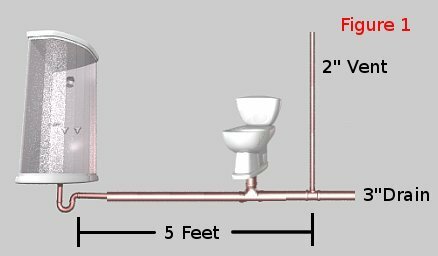Most of the houses have two different systems, especially when we talk of the filters of both the outlets. You can connect the waste pipes but connecting them in such a way that they share the same filter is not a very pleasant idea.
Technically Yes, you can have a system in which a toilet and a shower share the same drain. It can help you with more effective management. On the other hand, there can be hell a lot of reasons for not doing so.
Is it a good idea to combine both?
Here is a comparison with different pros and cons regarding having a common drain for toilet and shower.
| Pros | Cons |
| Saves you extra labor cost. | Minor mistakes can lead to complete failure of the system. |
| More efficient way of waste management. | Hard to provide the angles needed with the pipe fitting. |
| Makes the system less complicated. | Backflow of water can occur. |
| Will cost you less than providing different pipes for both of the systems. | If the system lacks finishing there are chances of interchange of water via opposite pathways. |
| Easy to repair and handle. | If one of these gets damaged the other too gets affected. |
| Consumes less space. | There will be a heavy load on the common vent. |
Reasons for connecting a Shower and Toilet in Same Drain
To be frank with you, there are minimal opinions that will suggest you connect both a toilet and a shower to a single drain. Here are the top reasons that are behind the logic-
1.) It can be light on your pocket– Every house is connected to a main or the central sewage system by pipes and connections. It may happen that you have a number of plumbing fixtures at your home.
Each of these needs a particular sewage discharge that can help them to find the main outlet. Now, if you have different pipelines, it is going to cost you more than ever.
The solution for this problem could be making a standard pipeline to the outlet. Even different pipeline systems will require setup and installation. This will cost you more labor.
To sum up, all of it is going to give you a hard time on your pocket. Hence connecting the toilet and shower to the same drain can be a good idea.
2.) It makes things less hectic– If you see the whole thing, having a system that has separate pipelines for all the outlets can be a very unpractical and hectic thing to do.
Not only will it cost you a lot of money, but it will require planning and many other things to do. If you don’t connect the system, then you will have to get away for each one of them out of the house. There is a massive load of installation.
Things like PVC pipes and connecting units can cost a lot of money. If you want to escape these things, it is better to find a way to connect the main pipes of the toilet and the shower to a single drain.
3.) Saves Space– If a Shower and toilet share the same drain, you will get an advantage over space management. The pipes will be connected with ease, and there will be a lot of space left for other stuff. It gets better for the plumbers to deal with any problems occurring in the system.
How to Connect the shower and toilet drain together?
From the above points, it is pretty clear that you can have a system in which you might connect a toilet and shower to the same drain. Now, this is a task that you can perform at your home without any outer support. But you need to have an idea of the Sewage system of your house.
There Can be many complicated parts, and disturbing them is really going to hurt you hard. Sewage is an area that needs to be treated well, or things can get out of control. Get some information on all the sewage systems of your house.
Further, you can go and grab the required materials and stuff needed to perform the process. Get ready with your equipment. Remember, if at any point you feel that things are out of hand, stop and go for expert help. We will tell you the process of dealing with the situation next in the article.
1.) Get ready and make the preparations- This is a significant point in the entire process. You must go with investing a lot of time making up the preparations. Be ready with everything, even with the emergency plan and instruments needed, before you start.
Get a brief idea of the pipelines of your house. There must be a given amount of gap between two sewage pipes. This is essential data for you as this area can be a free space for you to work without any worries. Get other attachments ready.
Some of the things that you must get while starting will be PVC pipes, Advice, Saw and cutting instruments, connectors, PVC bends, and Caps. Remember that sewage pipes can be different in their diameter, and you must get your attachments according to the pipes inside your house.
2.) Deal with the Floor or Wall- Get the pepper idea of your Sewage pipes and their respective locations. The pipes can be below the ground or in the walls.
The next task will be going deep and finding different pipes. This is not an easy task at all. You need a tremendous amount of force to remove the tiles or dig in. It is temporarily going to ruin the looks of your bathroom and toilet.
You also will have to ensure that the water supply to your pipes is completely cut off by the valves, or it’s gonna be a colossal disaster once you open up the lines.
You also need accuracy here as digging the wrong location can be a waste of time and energy, and on the other hand, you will not get what you were looking for. So be very specific about the selection.
See also: Should you install tile first then shower door
3.) The Common Vent- If you don’t know the execution of such a vent in the Sewage system of your house, then you need to learn a lot before even thinking of the entire process. The pipe and the whole system from your shower and toilet have a lot to do with the way they are designed.
They have a specific design that prevents the formation of an extreme vacuum in the pies. This is done to avoid the water repulsion in the pipe, and by this, water can easily pass down the drain. Even there is methane trapped in the pipes to prevent the vacuum.
One needs to trace the exact location of the toilet and shower. The common vent should not be placed away more than 5 feet from these two. If you do so, then you will have to use a connecting vent to join the system.
There is no way that you can connect the shower outlet directly to the toilet trap, as this can spoil the entire thing. Installing a standard vent is the easiest and most effective way to do so.
4.) The shower connection- The next step is going to be an easy one. Once you are ready with your common vent, all you have to do is to connect different pipes to the vent.
The first thing you need to do here is to keep a system in your mind. The shower trap and all the piping regarding the shower should be held at a higher position than that of the toilet.
If you don’t keep this in mind, there can be a chance of wastewater returning from your toilet to your shower; I bet you will never want anything as such to happen, so better keep this point in mind.
The piping should be done in such a way that you can have an angulation. This means when you will be connecting the vent and the main shower pipe, you need to keep it tiled in at a certain angle.
This will help water to flow easily back to the vent and also ensures that you will not get the water back flowing via the pipe. For advice, try joining the pipe by your hands at first and then use the instrument. This prevents extra wear and tear.
5.) Toilet Connection- The next step in your procedure will be connecting the toilet with the vent. If you are wondering why we are going for the toilet connection after the shower, then always remember that in any process, you need to connect the toilet much later after the shower to check your system. If you fix the shower after the toilet, then there can be mistakes in the levels and other fixations.
Always remember that the pipes used in toilets must have the highest diameters. The water flowing through these pipes is going to have more water particles than that of the shower.
You never want a situation in which your main sewage people get blocked. In such a situation, you will have to reopen your sewage pipes to fix the blockage. Be very clear about the selection. Don’t get confused with the main drainage pipe and the secondary connecting ones.
See also: Korky vs Fluidmaster toilet repair kit comparison
6.) Testing and done– Once all your connections are made, you must test them. Now, this is a step that will tell if you succeeded or your process needs a better touch.
If the water flows in the vent and there is no such problem such as leakage or backflow, then congrats, you are done here. Test it with the full force of the water. There can be a situation when things don’t work out well, so be prepared for the worst.
Once you have tested everything, it’s time to fix everything back to where it was. You should take your time, In fixing up the wall or the floor. If any mistake happens while forcing the cement down, the pipes can get damaged, so be gentle and work smartly.
Conclusion
To answer the question ” Can a toilet and Shower Share the same drain?” straightforwardly, YES, they can if you do it in the correct way.
Messing up with your Sewage disposal can be a hard task, and sometimes it might land you into a situation where you will have to get dependent on your neighbors’ toilet for a few days.
We hope you will be able to run away from such a situation. The key here is to make smart and confident moves with patience while dealing with drainage.

